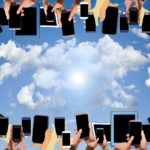As a result of widespread digitization, the demands on computing resources have also risen sharply. As a result, cloud computing is becoming more and more important. Due to the large amount of data and information and the urge for faster and more flexible solutions, the demands have also increased. More memory, better servers and a higher degree of software, network components and databases are now required.
The main advantage is that the user only pays for the cloud service actually used. This gives companies the opportunity to reduce their operating costs. At the same time, you can implement needs-based scaling in an effective infrastructure.
But how many companies have already recognized these opportunities? And what is the current usage rate?
Or to put it another way:
What is the status quo of cloud computing in companies?
How current statistics of the “Cloud Monitor 2019” from Bitkom show, almost three quarters of all companies already use cloud computing. This means that the use of cloud technologies has increased by almost 10 percent in just two years (2016-2018). This means that there are fewer and fewer objectors and more and more planned uses.

But even if cloud computing seems to be gaining ground across the board, the type of use and the forms of data backup have changed in recent years. While the first phases of rapprochement were cautious in 2016, more trust has now developed. The storage of uncritical data has been reduced by 3 percentage points, while the backup has increased by ten percent between 2016 and 2018. And users have also discovered cloud computing for themselves when it comes to secret information. Here usage has even increased from 19 percent to 33 percent in just two years, which is a whole 14 percentage points.

What are the still problems with implementation and use?
But even if trust in cloud technologies is steadily increasing, the implementation seems to be a real problem for some companies. Many management levels are longing for more productivity and competitiveness and find the apparently optimal solution in the outsourcing of information, data and entire programs to the computers of Internet service providers. At the same time, however, there is often one thing missing: qualified, expert-based personnel with whom the change can be efficiently implemented. This is probably the main reason for still almost 1/5 of refusals as well as the still main use of cloud computing for uncritical information.
In particular, the fact that cloud computing is sometimes difficult to access for the average employee with little IT knowledge, often leads to inferior uses, as shown in the following graphic, for example:

Due to the implementation of cloud technologies, large parts of the workforce are often ready to use them in their everyday work, but at the same time the resources are lacking. And the background knowledge for optimal application is not always available. This often leads to chaotic situations in which information is uploaded to the cloud, but there is no uniform system behind it. As a result, the system can quickly become inefficient and lose flexibility and speed. Ultimately, this means that processes can only be scaled poorly and unnecessary costs arise.
Conclusion
Still, I see far more benefit than harm in using cloud computing. Of course, the principle of cloud technologies is not easy to understand for everyone. At the same time, however, the opportunities outweigh so much that it can be worthwhile for companies to invest a little more at the beginning. These investments should be used to get the right specialists for a successful implementation.
In addition, I recommend companies that are already using cloud technologies to stay on the ball. Cloud computing should be used consistently. As the statistics from Bitkom Monitoring show, trust in the cloud is increasing steadily. This also means that more and more secret data is securely stored.
Tip: Read my new book: The way to the cloud at Springer Gabler or book me for a talk .
source
Lindner, D., Niebler, P., & Wenzel, M. (2020). The way to the cloud – a guide for entrepreneurs and decision-makers . Heidelberg: Springer Gabler.
You can find more information on the subject in the following articles:
- What is cloud computing?
- Opportunities and advantages of cloud computing
- Risks and Disadvantages of Cloud Computing
- Cloud Computing: Private or Public Cloud?
Image source: pixabay.com
[fotolia]


